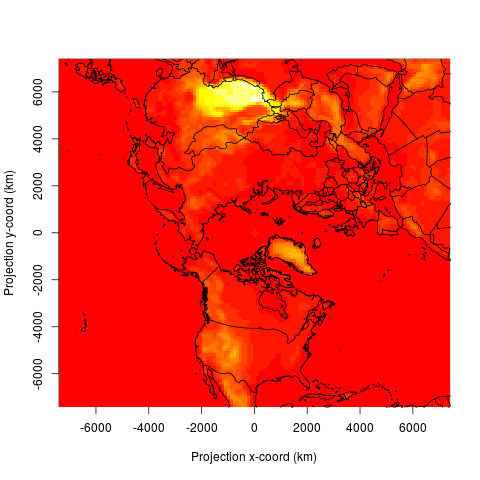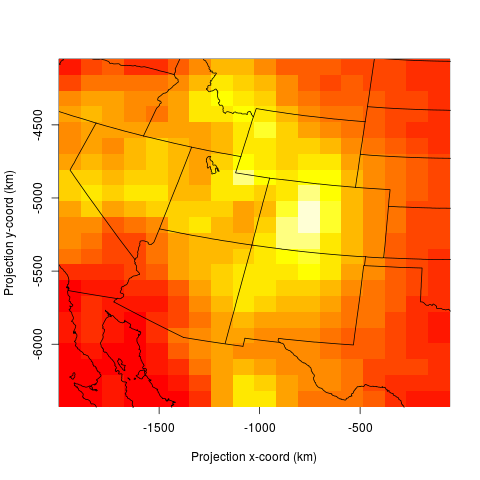Supported by Dr. Osamu Ogasawara and  providing providing  . . |
|
Last data update: 2014.03.03 |
Get map lines in the model projection unitsDescriptionGet map lines in the model projection units. Usageget.map.lines.M3.proj(file, database = "state", units, ...) Arguments
DetailsThis function depends on the maps and mapdata
packages to get the appropriate map boundary lines (for states,
countries, etc.), ncdf4 to read the projection information from
the Models3-formatted file (using a call to function
ValueMap lines for the projection described in WarningThis function will only work with Lambert conic conformal or polar stereographic projections. Author(s)Jenise Swall ReferencesSee Also
Examples
## Find the path to the demo file.
polar.file <- system.file("extdata/surfinfo_polar.ncf", package="M3")
## Read in the terrain elevation variable.
elev <- get.M3.var(file=polar.file, var="HT")
## Make a plot.
image(elev$x.cell.ctr, elev$y.cell.ctr, elev$data[,,1],
xlab="Projection x-coord (km)", ylab="Projection y-coord (km)",
zlim=range(elev$data[,,1]), col=heat.colors(15))
## Superimpose national boundaries on the plot
nat.bds <- get.map.lines.M3.proj(file=polar.file, database="world")$coords
lines(nat.bds)
## Subset to a smaller geographic area in southwestern U.S.
subset.elev <- var.subset(elev, llx=-2000, urx=0, lly=-6500, ury=-4000)
## Make a plot of this subset.
image(subset.elev$x.cell.ctr, subset.elev$y.cell.ctr,
subset.elev$data[,,1], xlab="Projection x-coord (km)",
ylab="Projection y-coord (km)", zlim=range(subset.elev$data[,,1]),
col=heat.colors(15))
## Superimpose Mexico, US, and Candadian national borders on the plot,
## along with state borders.
canusamex.bds <- get.map.lines.M3.proj(file=polar.file, "canusamex")$coords
lines(canusamex.bds)
Results
R version 3.3.1 (2016-06-21) -- "Bug in Your Hair"
Copyright (C) 2016 The R Foundation for Statistical Computing
Platform: x86_64-pc-linux-gnu (64-bit)
R is free software and comes with ABSOLUTELY NO WARRANTY.
You are welcome to redistribute it under certain conditions.
Type 'license()' or 'licence()' for distribution details.
R is a collaborative project with many contributors.
Type 'contributors()' for more information and
'citation()' on how to cite R or R packages in publications.
Type 'demo()' for some demos, 'help()' for on-line help, or
'help.start()' for an HTML browser interface to help.
Type 'q()' to quit R.
> library(M3)
Loading required package: ncdf4
Loading required package: rgdal
Loading required package: sp
rgdal: version: 1.1-10, (SVN revision 622)
Geospatial Data Abstraction Library extensions to R successfully loaded
Loaded GDAL runtime: GDAL 1.11.3, released 2015/09/16
Path to GDAL shared files: /usr/share/gdal/1.11
Loaded PROJ.4 runtime: Rel. 4.9.2, 08 September 2015, [PJ_VERSION: 492]
Path to PROJ.4 shared files: (autodetected)
Linking to sp version: 1.2-3
Loading required package: maps
# maps v3.1: updated 'world': all lakes moved to separate new #
# 'lakes' database. Type '?world' or 'news(package="maps")'. #
Loading required package: mapdata
> png(filename="/home/ddbj/snapshot/RGM3/R_CC/result/M3/get.map.lines.M3.proj.Rd_%03d_medium.png", width=480, height=480)
> ### Name: get.map.lines.M3.proj
> ### Title: Get map lines in the model projection units
> ### Aliases: get.map.lines.M3.proj
>
> ### ** Examples
>
> ## Find the path to the demo file.
> polar.file <- system.file("extdata/surfinfo_polar.ncf", package="M3")
>
> ## Read in the terrain elevation variable.
> elev <- get.M3.var(file=polar.file, var="HT")
Time independent file - reading only time step available.
> ## Make a plot.
> image(elev$x.cell.ctr, elev$y.cell.ctr, elev$data[,,1],
+ xlab="Projection x-coord (km)", ylab="Projection y-coord (km)",
+ zlim=range(elev$data[,,1]), col=heat.colors(15))
>
> ## Superimpose national boundaries on the plot
> nat.bds <- get.map.lines.M3.proj(file=polar.file, database="world")$coords
> lines(nat.bds)
>
>
> ## Subset to a smaller geographic area in southwestern U.S.
> subset.elev <- var.subset(elev, llx=-2000, urx=0, lly=-6500, ury=-4000)
> ## Make a plot of this subset.
> image(subset.elev$x.cell.ctr, subset.elev$y.cell.ctr,
+ subset.elev$data[,,1], xlab="Projection x-coord (km)",
+ ylab="Projection y-coord (km)", zlim=range(subset.elev$data[,,1]),
+ col=heat.colors(15))
>
> ## Superimpose Mexico, US, and Candadian national borders on the plot,
> ## along with state borders.
> canusamex.bds <- get.map.lines.M3.proj(file=polar.file, "canusamex")$coords
> lines(canusamex.bds)
>
>
>
>
>
> dev.off()
null device
1
>
|

